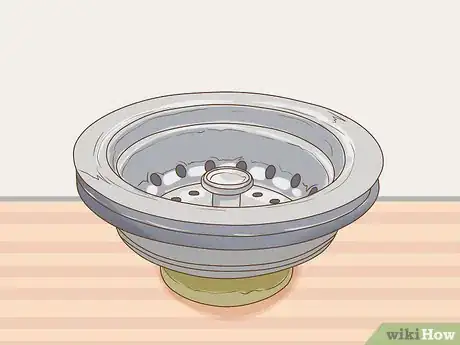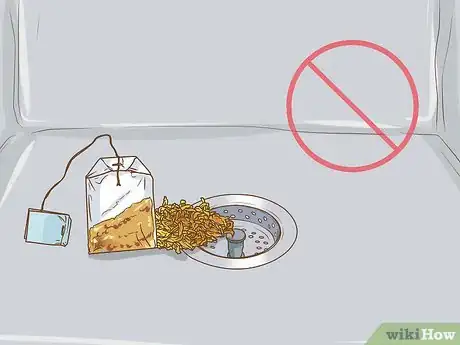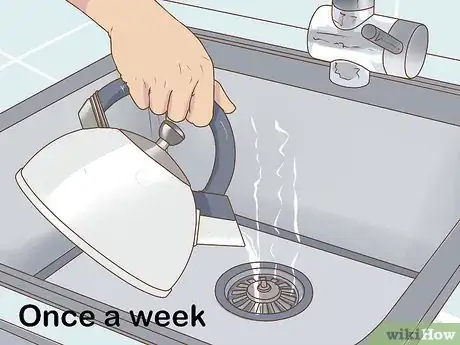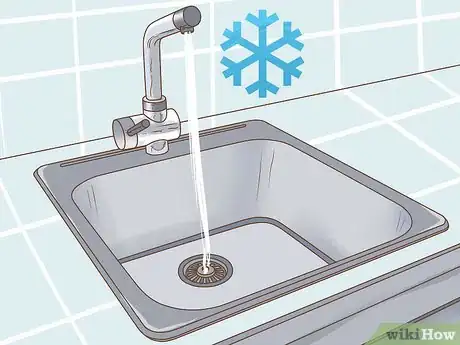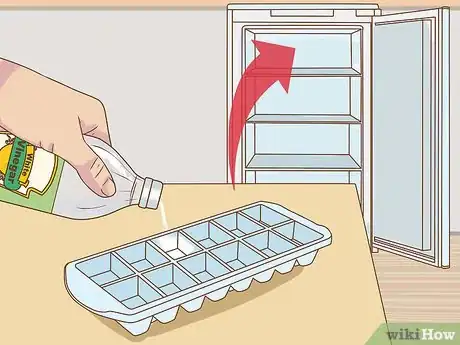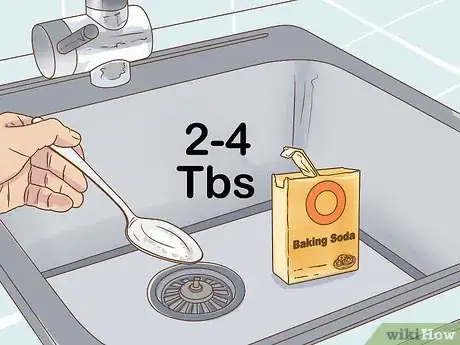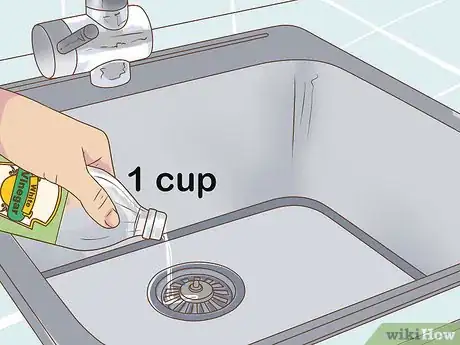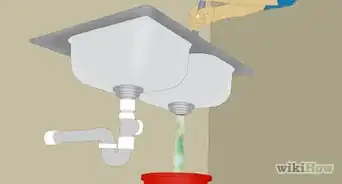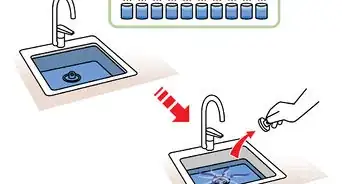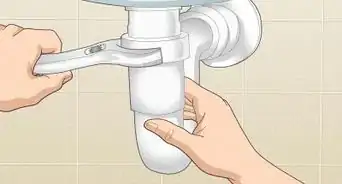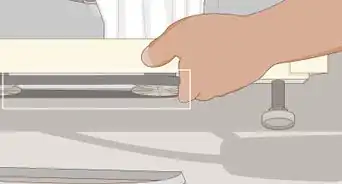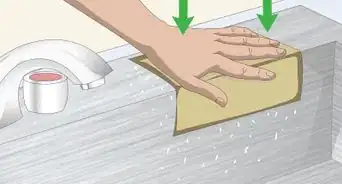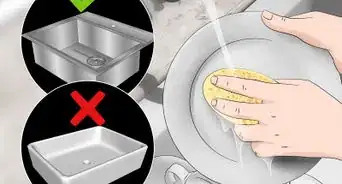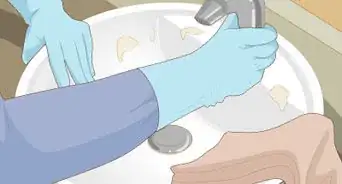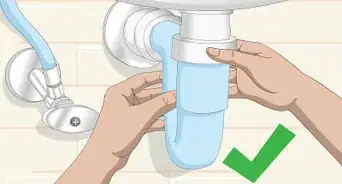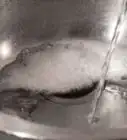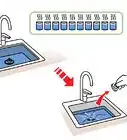This article was co-authored by Raymond Chiu. Raymond Chiu is the Director of Operations for MaidSailors.com, a residential and commercial cleaning service based in New York City that provides home and office cleaning services at affordable prices. He has a Bachelors in Business Administration and Management from Baruch College.
wikiHow marks an article as reader-approved once it receives enough positive feedback. In this case, 83% of readers who voted found the article helpful, earning it our reader-approved status.
This article has been viewed 54,764 times.
There is a lot of advice available for how to clear your kitchen sink after it's blocked, but it can be even more helpful to prevent a blockage in the first place. By following some basic guidelines (depending on your style of sink) and doing a bit of routine flushing, you can successfully avoid back-ups and blockages in your kitchen sink.
Steps
Preventing Clogs in Basic Sinks
-
1Use a drain strainer. If you do not have a garbage disposal unit installed in your sink, it is very important to avoid letting food scraps go down the drain. Find a drain strainer that fits the opening of your sink and use it collect food scraps.[1]
- A wide variety of drain strainers are available at hardware stores.
- It can be helpful to bring along a photo of your sink and ask a sales associate to help you choose the right one.
-
2Avoid pouring grease or oil down the drain. Never pour hot fat down the kitchen sink. The fat will cool down, congeal, and set in the pipes. The best approach is to let fats/oils cool in a container (such as a coffee can) and place the solid fat into the garbage bin.[2]Advertisement
-
3Avoid putting tea leaves down the sink drain. Tea leaves can accumulate in the drain, expand, and clog at the S-bend. As such, it is important to prevent tea leaves from going down the drain. Throw your tea leaves in the trash, or you can use them in compost if you have a garden.[3]
-
4Pour hot water down the drain weekly. Even if you are careful, a small amount of food and/or fats can make their way down your drain. In order to prevent blockages, it is a good idea to pour boiling hot water down your sink about once a week. Heat some water in a kettle, and pour it slowly down the drain.[4]
Preventing Clogs in Sinks with Disposals
-
1Avoid putting "problem foods" through your disposal. If you have a garbage disposal, you don't need to worry as much about food scraps. However, there are a handful of foods that can cause problems for garbage disposals and lead to blockages in your kitchen sink.[5] These "problem foods" include:
- Banana peels
- Coffee grounds
- Potato skins
- Rice and pasta
- Eggshells
- Bones
-
2Run cold water while you use your disposal. Even though a garbage disposal is specifically designed to grind up scraps of food, things can still get stuck. One way to prevent this from happening is to run a stream of cold water from the faucet anytime your run your garbage disposal. This helps to clear away any stubborn foods scraps and clear up potential clogs.
-
3Clean the disposal with a specialized brush each week. Look online or in your local hardware store for a brush designed to clean sink disposals. Each week, unplug your disposal so it doesn’t have power running to it. Then, use the brush to loosen debris and grime from the disposal. Flush hot water down the drain to clear away the loosened bits. Then, plug the disposal back in to the power source.
-
4Use vinegar ice cubes to clean the disposal monthly. If you use your garbage disposal frequently, doing a bit of preventative maintenance can help prevent blockages. A natural and effective method is to use vinegar ice cubes. Pour white vinegar into an ice cube tray until it is half-full, and top it off with water (because vinegar will not freeze on its own). Then place the tray in the freezer for several hours. When they have frozen, toss the vinegar ice cubes into your disposal and turn it on. [6]
- Be sure to label your vinegar ice cubes in the freezer. It would be awful for a family members to use them in a beverage!
Flushing Your Drain
-
1Sprinkle baking soda down the drain monthly. You can help to prevent drain blockages by regularly flushing your drain. Sprinkle 2-4 tablespoons (28.8-57.6 g) of baking soda down your drain. Follow this with hot water from your faucet, letting the hot water run for 2-3 minutes.[7]
- Consider doing a baking soda flush once a month, or any time your drain seems slow.
-
2Pour vinegar down the drain if you don’t have baking soda. Another option for your monthly drain-flush is to use white vinegar. Pour 1 cup (240 ml) of white vinegar down the drain, and wait 30 minutes. Follow with hot water from your faucet, letting the water run for 2-3 minutes. [8]
- White vinegar contains acetic acid, which is excellent at dissolving built up grime in your pipes.
-
3Perform a deep cleaning with salt, baking soda, and vinegar. If you have experienced clogs in the past, or if it has been a long time since you've done a flush, you may want to do a deeper cleaning. For this you can combine 1/2 cup (136.5 g) of salt with 1/2 cup (136.5 g) of baking soda and pour this down the drain. Follow this with 1⁄2 cup (120 ml) of white vinegar, and wait 15 minutes for the mixture to foam. Then pour 8 cups (1,900 ml) of hot water down the drain to rinse it out.[9]
Expert Q&A
Did you know you can get expert answers for this article?
Unlock expert answers by supporting wikiHow
-
QuestionHow do I stop my kitchen sink from clogging?
 Raymond ChiuRaymond Chiu is the Director of Operations for MaidSailors.com, a residential and commercial cleaning service based in New York City that provides home and office cleaning services at affordable prices. He has a Bachelors in Business Administration and Management from Baruch College.
Raymond ChiuRaymond Chiu is the Director of Operations for MaidSailors.com, a residential and commercial cleaning service based in New York City that provides home and office cleaning services at affordable prices. He has a Bachelors in Business Administration and Management from Baruch College.
House Cleaning Professional
-
QuestionMy garbage disposal is grinding and something has gone down the drain. Do I need to call a plumber, or can I fix this myself?
 Community AnswerIf you can find the manual of the garbage disposal, it will provide the steps to carefully disassemble the disposal and remove foreign material. If you don't have a copy of the manual, you will be able to find the model number printed on the disposal itself (somewhere under the sink, on the disposal body or on a metal plaque installed nearby) and with this number you can find the manual online. It is important to disconnect power to the garbage disposal before trying to disassemble parts for repair, this is why having the manual to follow the proper steps is important if you are going to try to do it yourself.
Community AnswerIf you can find the manual of the garbage disposal, it will provide the steps to carefully disassemble the disposal and remove foreign material. If you don't have a copy of the manual, you will be able to find the model number printed on the disposal itself (somewhere under the sink, on the disposal body or on a metal plaque installed nearby) and with this number you can find the manual online. It is important to disconnect power to the garbage disposal before trying to disassemble parts for repair, this is why having the manual to follow the proper steps is important if you are going to try to do it yourself.
Warnings
- Always unplug your garbage disposal before cleaning it.⧼thumbs_response⧽
References
- ↑ https://www.familyhandyman.com/plumbing/how-to-prevent-clogged-drains#11
- ↑ https://www.familyhandyman.com/plumbing/how-to-prevent-clogged-drains#11
- ↑ http://www.mnn.com/lifestyle/recycling/stories/20-ways-to-reuse-coffee-grounds-tea-leaves
- ↑ http://www.dummies.com/home-garden/plumbing/clogs/how-to-prevent-clogs-in-your-drains/
- ↑ http://www.delish.com/food-news/g3164/things-you-should-never-put-down-your-garbage-disposal/
- ↑ http://www.dummies.com/home-garden/plumbing/clogs/how-to-prevent-clogs-in-your-drains/
- ↑ http://www.dummies.com/home-garden/plumbing/clogs/how-to-prevent-clogs-in-your-drains/
- ↑ http://www.dummies.com/home-garden/plumbing/clogs/how-to-prevent-clogs-in-your-drains/
- ↑ http://www.dummies.com/home-garden/plumbing/clogs/how-to-prevent-clogs-in-your-drains/
